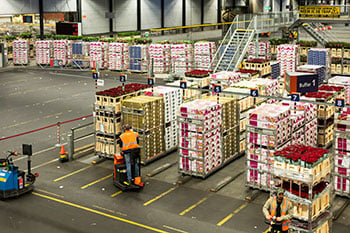In the fast-paced world of warehouses, distribution centers, and order fulfillment operations, nothing can put a damper on business growth more than hitting or nearing maximum capacity. The instinctive response might be to consider costly options like facility expansion or relocation.
operations, nothing can put a damper on business growth more than hitting or nearing maximum capacity. The instinctive response might be to consider costly options like facility expansion or relocation.
However, before venturing down that road, it's time to pause and ponder: Are you utilizing your existing warehouse space to its maximum efficiency? Is there room for optimization to prolong the life of your current facility? Let's embark on a capacity analysis journey to explore the possibilities and uncover the secrets to unlocking your warehouse's true potential.
A Well-Planned Warehouse Capacity Analysis
To understand where you're going, you must first grasp where you stand. A comprehensive warehouse capacity analysis is the key to shedding light on the present state of your warehouse operations. This entails exploring crucial factors that play a pivotal role in any thorough capacity analysis. This is a critical aspect to warehouse optimization.
Leveraging Your Distribution and Order Fulfillment Data
Good data is at the heart of every warehouse analysis. Delve deep into your business data, dissecting item/SKU information, order history, and throughput metrics.
Grasping the ins and outs of your inventory, including physical characteristics and storage requirements, is paramount to evaluating capacity.
Equally essential is understanding order processing patterns and shipping KPIs, providing you with the much-needed insights into your operational efficiency.
How Your Warehouse Infrastructure Affects Capacity
Your facility's attributes are like puzzle pieces that define your storage potential. Measure the footprint and clear height and consider structural elements like structural columns that can shape the flow of products.
Unearthing hidden treasures of space, such as vertical storage racks, can optimize your warehouse's vertical cube and turn wasted space into valuable real estate. Simple automation, such as Vertical Lift Modules (VLMs) and Vertical Carousels, offers a one-way ticket to saving up to 85% of otherwise squandered space.
If the stars align, a mezzanine might be your gateway to additional storage space, enriching your warehouse's potential.
Understanding how Processes can Impact Warehouse Capacity
Like a choreographer perfecting a dance, understanding your inventory flow is vital to discovering optimization opportunities. Follow the rhythm of your workflows, from receiving and putaway to replenishment, inventory management, picking strategies, packing, shipping, and everything in between.
The orchestra of personnel and technology plays a significant role in your operational symphony. And don't forget to harmonize inbound and outbound product flow for the full experience.
Planning for Future Warehouse Capacity Needs
The journey doesn't end with the present; it extends far into the future. Consider your business's growth plans and how they might influence the insights and recommendations derived from the analysis.
Anticipating Capacity Needs
Unlock the crystal ball of sales and inventory forecasting to predict your future capacity needs. Prepare for shifts in sales and understand how they might impact storage and throughput requirements, allowing you to strategize and invest wisely.
Dynamic SKU Evolution: Adapting to Changing Inventory
As seasons change, so do your product lines. Be prepared for introductions, expansions, or retirements that may impact storage requirements and workflows. Stay ahead of the curve and incorporate planned changes to your SKU lineup in your capacity analysis.
Beyond the Basics: Adding Value to Service Level Agreement
Offering value-added services like kitting, gift-wrapping, or lightning-fast shipping can drive demand and influence customer orders. Don't forget to account for their effects on workflows, processes and capacity requirements in your capacity analysis.
Evaluating Labor Impact
The heartbeat of any operation lies within the workforce. Substantial changes, like altering the number of workers or shifts, can cause seismic shifts in your workflows and throughput capacity. Let the impact of labor changes guide your capacity analysis.
In Conclusion
The treasure trove of insights from an effective capacity analysis is your compass to navigate uncharted waters. Armed with knowledge, unleash your warehouse's true potential. Refine workflows, embrace optimization, and implement technologies to soar to new heights of capacity and efficiency.
Embrace the wisdom of a trusted systems integrator, who can provide a fresh perspective and guide you through the transformation.
As the curtain falls on our capacity analysis journey, we unveil the secrets to unlocking your warehouse's full potential. Embrace the power of optimization and efficiency to propel your business forward.
Avoid the capacity roadblock and turn it into a launchpad for growth. With the right insights and a clear vision, your warehouse can become a thriving hub, where expansion and success know no bounds.
Consider working with a warehouse consultant to assist with improving your warehouse operations.




SHARE